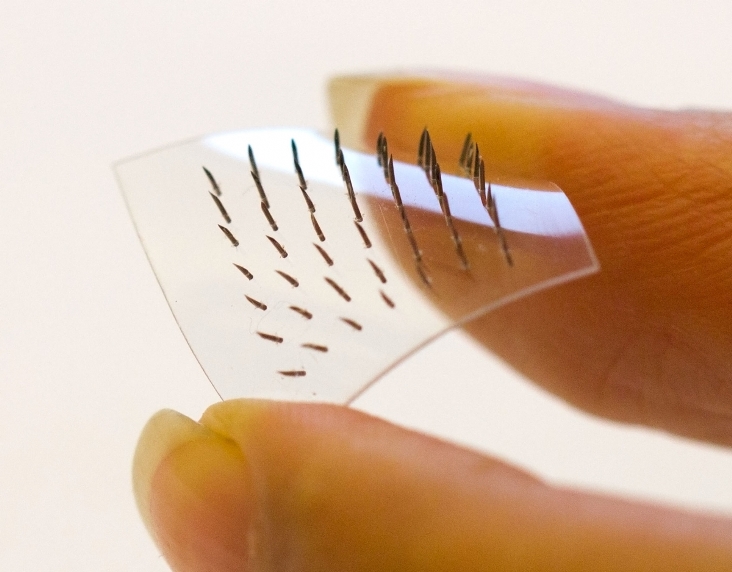
A flexible base, combined with stainless steel needles, could make the patch created at KTH an effective alternative to injections.
It’s only a matter of time before drugs are administered via patches with painless microneedles instead of unpleasant injections. But designers need to balance the need for flexible, comfortable-to-wear material with effective microneedle penetration of the skin. Researchers from KTH Royal Institute of Technology in Stockholm say they may have cracked the problem.
In the recent volume of PLOS ONE, the research team from KTH reports a successful test of its microneedle patch, which combines stainless steel needles embedded in a soft polymer base — the first such combination believed to be scientifically studied. The soft material makes it comfortable to wear, while the stiff needles ensure reliable skin penetration.
Unlike epidermal patches, microneedles penetrate the upper layer of the skin, just enough to avoid touching the nerves. This enables delivery of drugs, extraction of physiological signals for fitness monitoring devices, extracting body fluids for real-time monitoring of glucose, pH level and other diagnostic markers, as well as skin treatments in cosmetics and bioelectric treatments.
Frank Niklaus, professor of micro and nanofabrication at KTH, says that practically all microneedle arrays being tested today are “monoliths”, that is, the needles and their supporting base are made of the same — often hard and stiff — material. While that allows the microneedles to penetrate the skin, they are uncomfortable to wear. On the other hand, if the whole array is made from softer materials, they may fit more comfortably, but soft needles are less reliable for penetrating the skin.
“To the best of our knowledge, flexible and stretchable patches with arrays of sharp and stiff microneedles have not been demonstrated to date,” he says.
They actually tested two variations of their concept, one which was stretchable and slightly more flexible than the other. The more flexible patch, which has a base of molded thiol-ene-epoxy-based thermoset film, conformed well to deformations of the skin surface and each of the 50 needles penetrated the skin during a 30-minute test.
A successful microneedle product could have major implications for health care delivery. “The chronically ill would not have to take daily injections,” says co-author Niclas Roxhed, who is research leader at the Department of Micro and Nano Systems at KTH.
In addition to addressing people’s reluctance to take painful shots, microneedles also offer a hygiene benefit. The World Health Organization estimates that about 1.3 million people die worldwide each year due to improper handling of needles.
“Since the patch does not enter the bloodstream, there is less risk of spreading infections,” Roxhed says.
The report, Flexible and Stretchable Microneedle Patches with Integrated Rigid Stainless Steel Microneedles for Transdermal Biointerfacing, was coauthored by Mina Rajabi, Niclas Roxhed, Tommy Haraldson, Andreas. C. Fischer, Göran Stemme, Reza Shafagh, Wouter Van Der Wijngaart, and Frank Niklaus.




